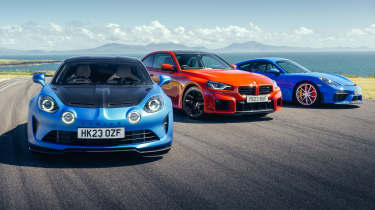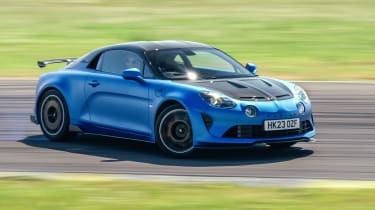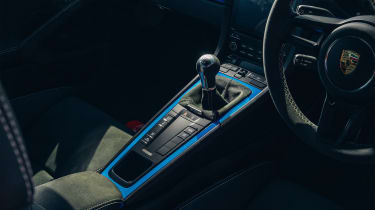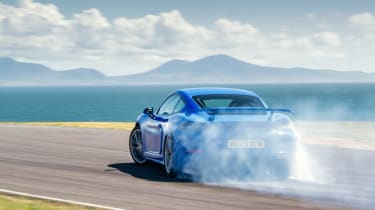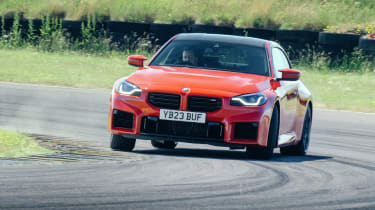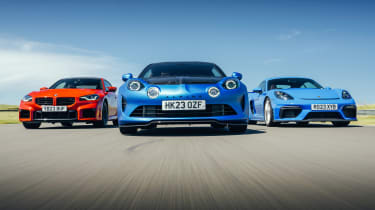BMW M2 v Porsche Cayman GT4 v Alpine A110 R: ultimate track test
They’ve squared up on the road; now A110 R, GT4 and M2 head to Anglesey for timed laps. Place your bets
618 kilos. That’s what separates the official kerb weights of our three protagonists, the M2 a whopping 1700kg, 1420kg for the Cayman GT4 and 1082kg for the A110 R. It’s a huge disparity. One that points to just how light the Alpine is (remarkably so in the context of 2023), how bulky BMW’s ‘baby’ M car has become, and how even Porsche is fighting to keep the kilos in check.
Nowhere punishes excess mass like a racetrack, but it’s equally true to say big power – and more importantly, ample torque – can go a long way to mitigate its effects. Anglesey’s 1.8-mile Coastal Circuit has a wicked blend of tricky corners and big braking areas, but it also rewards cars with the grunt to haul themselves out of slow corners.
> BMW M2 v Porsche Cayman GT4 v Alpine A110 R: Are these 2023's best sports cars?
We complete two timed runs in each car: three flyers in Track mode and/or with the most relaxed ESC mode engaged, followed by another trio of push laps with all driver aids switched off to drive free from overly protective electronics and reveal any nasty traits. Given the power/torque-to-weight stats and tyre fitments, the finishing order isn’t a great surprise, the GT4 posting a best of 1:15.2 with TC on and 1:15.1 with all systems disabled, the Alpine nailing a 1:16.2 in Track mode and 1:16.4 with ESC off, and the M2 trailing on a 1:17.4 and 1:18.1. However, it’s the manner in which these times are achieved that’s most revealing.
Let’s start with the A110 R. Easily the lightest, but also the least powerful with 296bhp and 251lb ft, it looks and feels the most authentic track car. That was its brief, after all, yet when we drove it for the first time on the international press launch in Spain it lacked sparkle and excitement around the Jarama circuit.
Happily, Anglesey’s pleasing flow and more nuanced mix of corners seem to suit it better. They work the chassis hard enough to reveal exceptional poise, its balance inherently neutral, but allowing a little throttle adjustability. Make that plenty if you’re lobbing it towards Aston Parrott’s camera lens.
During timed laps the front works hardest, as there’s not enough grunt to unstick the rear. Consequently you find yourself managing mild understeer. This said, rapid direction changes see the tail help to rotate the car without upsetting your progress. It’s brilliantly stable under braking, too, so you really can divebomb the braking zones and keep the nose pinned on your way towards the apex.
We’d love a manual option, but the A110 R’s DCT is effective and feels appropriate. The only chink is under extreme braking into Rocket, where you have to lose the best part of 100mph and downshift from fifth to second in a difficult and compressed braking zone. It nails every shift to third but pauses before slotting second. The delay is just long enough to have another pull at the paddle, which then drops you into first gear. I learn to trust that second will arrive eventually, but the transmission clearly needs the wits to match the car’s braking ability.
The bigger frustration is the engine’s lack of reach and flat delivery. With a bit more low-end torque you could drive around the issue by taking some of the tighter corners in third gear instead of second. Sadly, it doesn’t quite have the grunt, so you select second knowing that you’ll run out of revs before you’ve exited the corner.
These mid-corner shifts reveal another problem – namely the awkward positioning of the column-mounted upshift paddle. Anglesey’s key corners are almost all right-handers, so when you try to pull an upshift with steering lock applied it’s almost impossible to thread your fingers between the chunky volume control and windscreen wiper stalks.
Despite the gripes, across a lap the Alpine is super-consistent and inspires huge confidence. You can take real liberties safe in the knowledge it never does anything unexpected, so it’s perfect for all ranges of ability and experience. Few track-biased cars would make a more rounded partner on a big road trip to Spa or the Nürburgring.
I enjoy the R more at Anglesey than Jarama, but still feel the car is let down by its powertrain. A modest remap by Life110 (other Alpine tuners are available) would help with the torque deficit, but the intense demands of track use make it difficult to overlook that this is a £90k car with a hot hatch engine.
It says a lot for the R’s compactness and baby-exotic feel that it makes the Cayman seem big and a little mainstream. It’s still a nice place to be, though, sitting low in the supportive bucket seat, and this GT4 is manual, so there’s the added bonus (and challenge) of three pedals and a stick.
As soon as you twist the ignition key the GT4 has you by the heartstrings. This motor isn’t as sweet as earlier generations of water-cooled flat-six, but it still sounds and feels tremendous, ruthlessly highlighting the Alpine’s more prosaic motor. With 414bhp and 310lb ft, the GT4 has significantly more firepower than the A110 R, too, but its extra weight and notoriously tall intermediate gearing reduce the on-paper advantage.
It’s a very different kind of mid-engined experience, the Porsche feeling more up on its tiptoes and requiring busier hands to guide through the timed laps. There’s some mild rear instability under braking – more of a shimmy than anything requiring steering correction, but the Cayman’s tail is generally more mobile than that of the super-grippy and steadfastly neutral Alpine.
The gearing really helps as you can hold second or third where the Alpine would need at least one upshift. There’s an auto-blipper function for downshifts, but the pedals are so nicely placed and the gearshift so snappy it’s a cinch to heel-and-toe. Throttle response is wonderful, and the way the engine builds to a sharp, howling crescendo makes every lap an absolute pleasure.
Tellingly there’s no Track mode. Instead you elect to put the dampers into their stiffer setting and then decide between keeping ESC/TC on, switching ESC off but leaving TC on, or disabling the whole lot. As a result the GT4 is resolutely consistent, with no contrived step up in response. It simply does what it does. Brilliantly.
Like the A110 R, the GT4 is on Cup 2 tyres. It works them well, finding terrific bite in fast and slow corners alike. Because the tail plays more of a role in the Cayman’s trajectory you don’t tend to work the front end quite so hard, but there are times when you can’t chase the throttle quite as rapidly as in the Alpine because you’re balancing front-end grip against rear-end traction. You know you’re finding the limit when you feel the TC working quietly in the background. When switched off you can let the rear tyres slightly over-rotate, which is hugely satisfying, especially as it’s also a fraction quicker.
The PCCB brakes fitted to this test car provide brilliantly consistent stopping power, but you can feel the GT4’s weight compared with the A110 R and need to brake a little earlier into the heaviest braking zones, though as with the Alpine you never feel the GT4’s ABS trigger, no matter how hard you try.
And so to the M2. Standard-fit Pilot Sport 4 S tyres place it at an immediate disadvantage, but even if we’d levelled the playing field by bolting on a set of Cup 2s it wouldn’t address the new M2’s sense of bulk. Where its predecessor had a pleasing compactness and a clenched-fist demeanour, the new car clearly struggles with its size and weight.
The engine is potent – 454bhp and 406lb ft make mincemeat of the Alpine and monster the GT4 – and the manual gearbox brings a pleasing sense of connection. But trying to put a decent run of timed laps together reveals a car that’s at odds with itself, mostly due to front and rear ends that aren’t well matched.
Using a moderate level of assistance from the adjustable MDM-controlled DSC, the front tyres struggle through the longer, quicker corners while the rear is traction-limited out of the tighter turns. Switch everything off and the car feels freer and more fun, but you can feel time ebbing away every time you ask for a direction change or chase the throttle.
The bigger issue is a surprising lack of finesse to the brake response and the rear end’s breakaway characteristics. The middle pedal is generally squishy and never gives you much confidence, though fade isn’t a factor. The step up in servo assistance is the bigger issue, a small amount of additional pressure yielding an abrupt and unsettling uptick in braking force. There’s a similar step in the way the rear end hooks up, with a marked difference in how the M2 finds and breaks traction. Try to carry more speed into the corner and the front tends to wash wide, but try a measured slow-in, fast-out method and the result is a spike of early oversteer.
Obviously, being an M car it’ll slide from here to Munich, which is fun (if you’re not paying for the tyres), but the underlying behaviour speaks of a car that’s outgrown its model designation. That’s hardly surprising given the M3/M4 underpinnings, but disappointing when the earlier M2, and indeed the 1M that preceded it, offered a different, sharper, punchier style of M-car driving experience.
A set of Cup 2s would almost certainly get the M2 into A110 R lap time territory around Anglesey, and the full CS treatment could be genuinely transformational (on road and track), but as it stands the new M2’s Motorsport genes are disappointingly recessive.
We recorded two runs of lap times for each car, one with the traction and stability control systems in Track mode or the closest equivalent, and one with the electronic systems switched off completely as a baseline. A cool down run was conducted between the sets of laps to avoid the tyres overheating.
Lap times
| Track mode | No assists | |
| Porsche 718 Cayman GT4 | 1.15.16 | 1.15.06 |
| Alpine A110 R | 1.16.16 | 1.16.40 |
| BMW M2 | 1.17.42 | 1.18.05 |
Specs
| Alpine A110 R | BMW M2 | Porsche 718 Cayman GT4 | |
| Engine | In-line 4-cyl, 1798cc, turbocharged | Straight-six, 2993cc, twin-turbo | Flat-six, 3995cc |
| Power | 296bhp @ 6300rpm | 454bhp @ 6250rpm | 414bhp @ 7600rpm |
| Torque | 251lb ft @ 2400-6000rpm | 406lb ft @ 2650-5870rpm | 310lb ft @ 5000-6800rpm |
| Weight | 1082kg (278bhp/ton) | 1700kg (271bhp/ton) | 1420kg (296bhp/ton) |
| 0-62mph | 3.9sec | 4.3sec (4.1sec auto) | 4.4sec |
| Top speed | 177mph | 177mph | 188mph |
| Basic price | £89,990 | £64,890 | £81,700 |
This story was first featured in evo issue 312.
